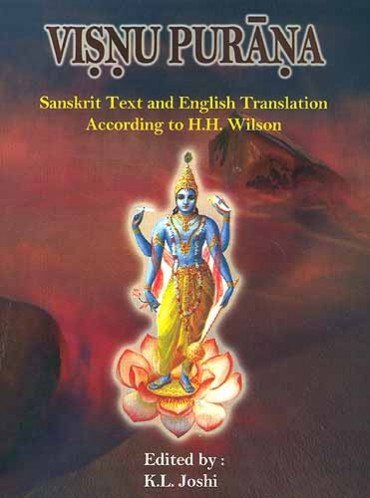The Vishnu Purana
by Horace Hayman Wilson | 1840 | 287,946 words | ISBN-10: 8171102127
The English translation of the Vishnu Purana. This is a primary sacred text of the Vaishnava branch of Hinduism. It is one of the eighteen greater Puranas, a branch of sacred Vedic literature which was first committed to writing during the first millennium of the common era. Like most of the other Puranas, this is a complete narrative from the cr...
9. The Bhaviṣya Purāṇa
9. Bhaviṣya Purāṇa. “The Purāṇa in which Brahmā, having described the greatness of the sun, explained to Manu the existence of the world, and the characters of all created things, in the course of the Aghora Kalpa; that, is called the Bhaviṣya, the stories being for the most part the events of a future period. It contains fourteen thousand five hundred stanzas[1].” This Purāṇa, as the name implies, should be a book of prophecies, foretelling what will be (bhaviṣyati), as the Matsya Purāṇa intimates. Whether such a work exists is doubtful. The copies, which appear to be entire, and of which there are three in the library of the East India Company, agreeing in their contents with two in my possession, contain about seven thousand stanzas. There is another work, entitled the Bhavishyottara, as if it was a continuation or supplement of the former, containing also about seven thousand verses; but the subjects of both these works are but to a very imperfect degree analogous to those to which the Matsya alludes[2].
The Bhaviṣya Purāṇa, as I have it, is a work in a hundred and twenty-six short chapters, repeated by Sumantu to Śatānīka, a king of the Paṇḍu family. He notices, however, its having originated with Swayambhu or Brahmā; and describes it as consisting of five parts; four dedicated, it should seem, to as many deities, as they are termed, Brahmā, Vaiṣṇava, Śaiva, and Tvāṣṭra; whilst the fifth is the Pratisarga, or repeated creation. Possibly the first part only may have come into my hands, although it does not so appear by the manuscript.
Whatever it may be, the work in question is not a Purāṇa. The first portion, indeed, treats of creation; but it is little else than a transcript of the words of the first chapter of Manu. The rest is entirely a manual of religious rites and ceremonies. It explains the ten Sanskāras, or initiatory rites; the performance of the Sandhya; the reverence to be shewn to a Guru; the duties of the different Āsramas and castes; and enjoins a number of Vratas, or observances of fasting and the like, appropriate to different lunar days. A few legends enliven the series of precepts. That of the sage Chyavana is told at considerable length, taken chiefly from the Mahābhārata. The Nāga Pañcami, or fifth lunation, sacred to the serpent-gods, gives rise to a description of different sorts of snakes. After these, which occupy about one-third of the chapters, the remainder of them conform in subject to one of the topics referred to by the Matsya. They chiefly represent conversations between Kṛṣṇa, his son Śāmba, who had become a leper by the curse of Durvāsas, Vaśiṣṭha, Nārada, and Vyāsa, upon the power and glory of the sun, and the manner in which he is to be worshipped. There is some curious matter in the last chapters, relating to the Magas, silent worshippers of the sun, from Sākadvīpa, as if the compiler had adopted the Persian term Magh, and connected the fire-worshippers of Iran with those of India. This is a subject, however, that requires farther investigation.
The Bhavishyottara is, equally with the preceding, a sort of manual of religious offices, the greater portion being appropriated to Vratas, and the remainder to the forms and circumstances with which gifts are to be presented. Many of the ceremonies are obsolete, or are observed in a different manner, as the Rath-yātrā, or car festival; and the Madanotsava, or festival of spring. The descriptions of these throw some light upon the public condition of the Hindu religion at a period probably prior to the Mohammedan conquest. The different ceremonies are illustrated by legends, which are sometimes ancient, as, for instance, the destruction of the god of love by Śiva, and his thence becoming Ananga, the disembodied lord of hearts. The work is supposed to be communicated by Kṛṣṇa to Yudhiṣṭhira, at a great assemblage of holy persons at the coronation of the latter, after the conclusion of the great war.
Footnotes and references:
[1]:

Click to view
[2]:
Col. Vans Kennedy states that he had not been able to procure the Bhaviṣya P., nor even ever to obtain any account of its contents: Anc. and Hindu Mythology, p.153, note.
